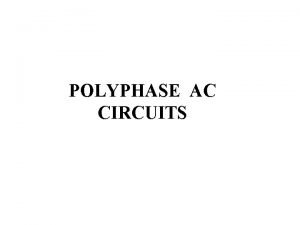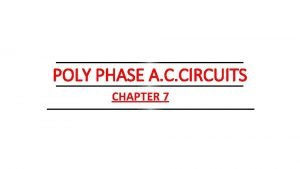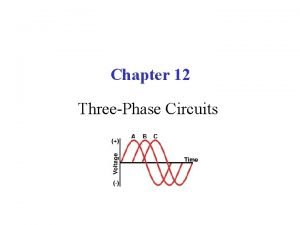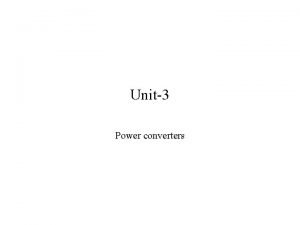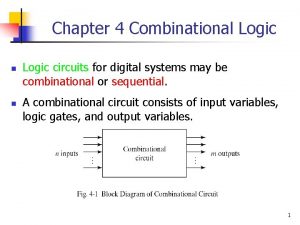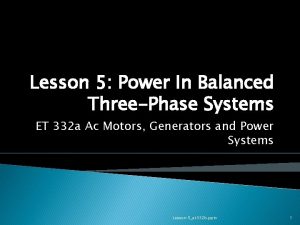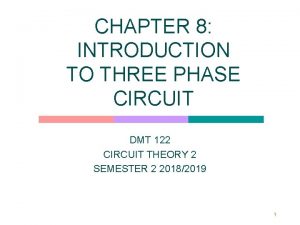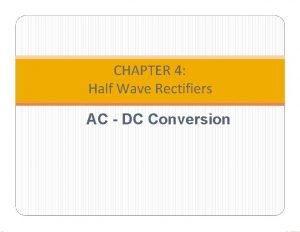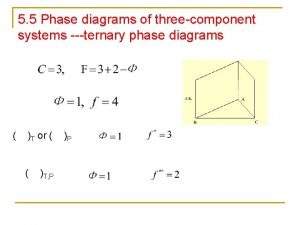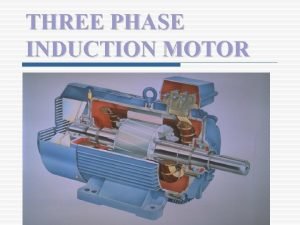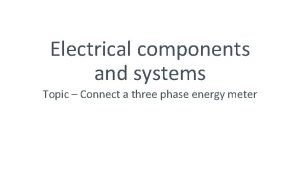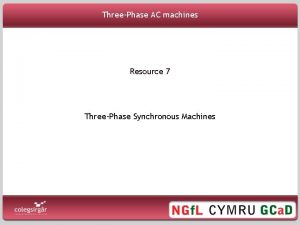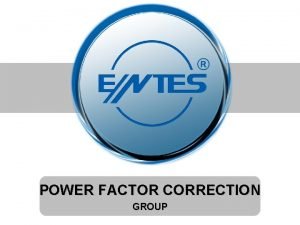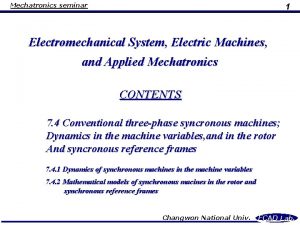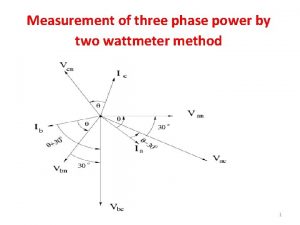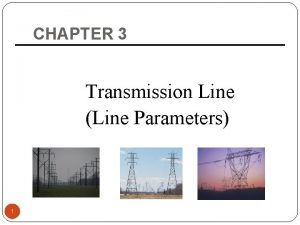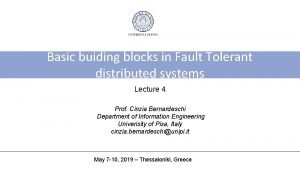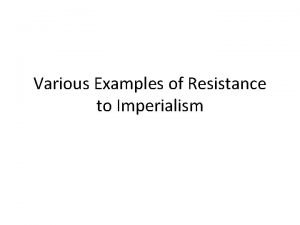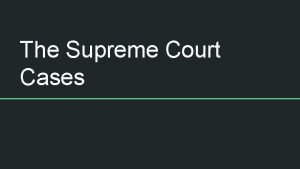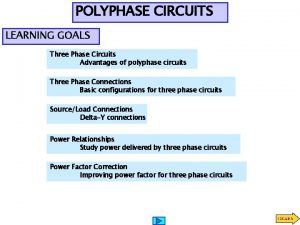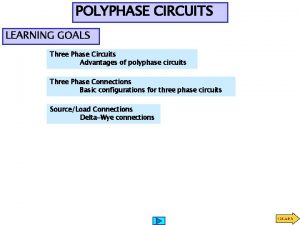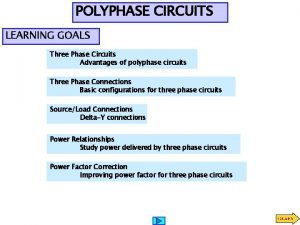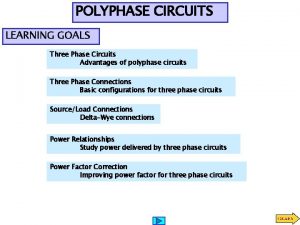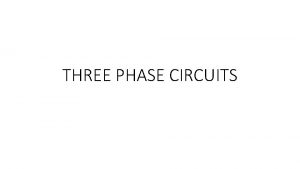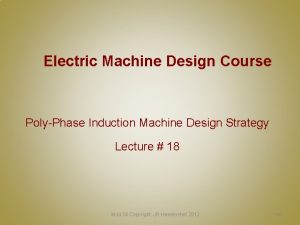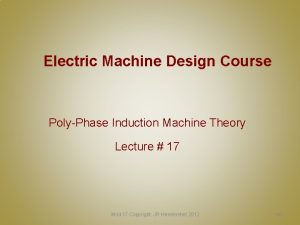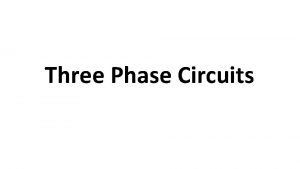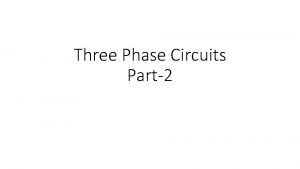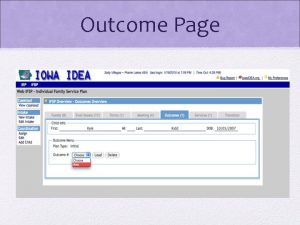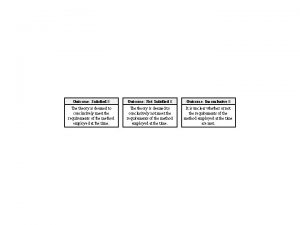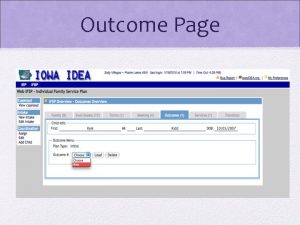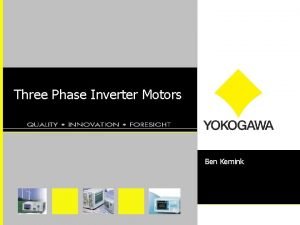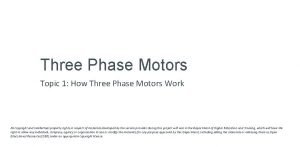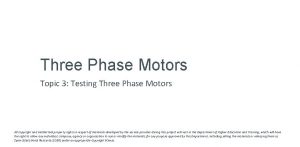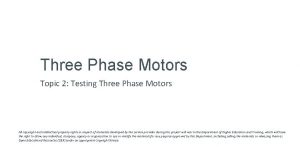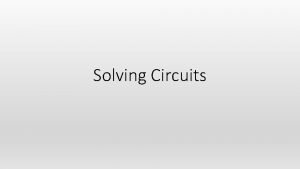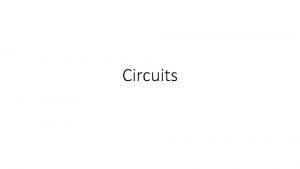POLYPHASE AC CIRCUITS Course Outcome Use three phase








































- Slides: 40

POLYPHASE AC CIRCUITS

Course Outcome • Use three phase AC supply for industrial equipment and machines.

Introduction to Polyphase AC Circuits • The domestic ac supply is single phase ac supply with 230 V/50 Hz. • But this ac supply is not suitable for certain applications. Some need a polyphase ac supply. • Polyphase ac supply is the one which produces many phases simultaneously. Ms. A. A. Lande E & TC Dept

Continued…. How to generate a polyphase ac supply? • The single phase ac voltage is generated by using a single phase alternator. Single phase alternator consists of only one armature winding. • But in order to generate a polyphase voltage, we have to use many armature winding. The number of windings is equal to the number of phases. Ms. A. A. Lande E & TC Dept

Three Phase Supply waveforms • A three phase system has proved to be the most economical as compared to the other systems. Hence in practice three phase systems is most preferred. • The three armature windings used for generation of a three phase supply are located at 1200 away from each other. • The voltages induced in these windings are of same amplitude and frequency, but they are displaced by 1200 with respect to each other as shown in fig. (1). Ms. A. A. Lande E & TC Dept

Continued…. fig. (1): Three phase voltage waveform Ms. A. A. Lande E & TC Dept

Advantages of Three Phase Systems over Single Phase System 1. 2. 3. 4. 5. 6. More output Smaller size Three phase motors are self starting More power is transmitted Smaller cross-sectional area of conductor Better power factor Ms. A. A. Lande E & TC Dept

Comparison of Single Phase & Three Phase Systems Sr. No. Parameter Single phase system Three phase system 1. Voltage Low(230 V) High (415 V) 2. Transmission efficiency Low High 3. Size of machines to produce same output Larger Smaller 4. Cross sectional area of Large conductors Small 5. Usage Industrial, large power applications Domestic, small power applications Ms. A. A. Lande E & TC Dept

Three Phase Emf Generation & its Waveform Principle: • The single phase supply is generated using a single turn alternator. • Thus if armature consists of only one winding, then only one alternating voltage is produced. • But if the armature winding is divided into three groups which are displaced by 1200 from each other, then it is possible to generate three alternating voltages. Ms. A. A. Lande E & TC Dept

Continued…. Construction: • As shown in fig. (1) the armature winding is divided into three groups. The three coils are R-R’, Y-Y’ and B-B’. • All these coils are mounted on the same shaft and are physically placed at 1200 from each other. • When these coils rotate in the flux produced by the permanent magnet, emf in induced into these coils. As shown in fig. (2), these emf are sinusoidal, of equal amplitudes and equal frequency but they are displaced from each other by 1200. • VR, VY and VB are three phase voltages. Ms. A. A. Lande E & TC Dept

Continued…. Fig. (1): Generation of a. E &3 -phase Ms. A. A. Lande TC Dept voltages

Continued…. Fig. (2): Voltages induced in the three coils Ms. A. A. Lande E & TC Dept

Continued…. • 1. 2. 3. If VR is considered as the reference, then we conclude that, VY lags VR by 1200. VB lags VY by 1200. In other words, VB lags VR by 2400. Fig. (3): Phasor representation of the three phase voltages Ms. A. A. Lande E & TC Dept

Continued…. • Mathematical representation: Ø The mathematical expression for the three induced voltages are given by: VR = Vm sin ωt VY = Vm sin (ωt-1200) VB = Vm sin (ωt-2400) = Vm sin (ωt+1200) Ms. A. A. Lande E & TC Dept

Continued…. • Phase sequence: Ø The phase sequence is defined as the sequence in which the three phases reach their maximum values. Normally the phase sequence is R-Y-B. • Importance of phase sequence: Ø The direction of rotation of three phase machines depends on the phase sequence. Ø If the phase sequence is changed e. g. R-B-Y then the direction of rotation will be reversed. Ø In order to avoid such things, the phase sequence of RY-B is always maintained. Ms. A. A. Lande E & TC Dept

Three Phase supply Connection • In three phase ac system, the three phase alternator has three separate windings one per each phase. • Hence the power generated in each phase can be transmitted independently to the load using 2 wires per winding. But this will requires 6 - different wires. • Eventhough such a system is practically possible, it makes the system complicated and expensive. • Hence in practice, the three windings of the alternator are interconnected in two different ways to reduced the number of wires required for the connections Ms. A. A. Lande E & TC Dept

Continued…. Types of connection Three phase three wire star (wye) connection Three phase four wire star connection Ms. A. A. Lande E & TC Dept Three phase three wire delta connection

Star Connection(wye connection) • This configuration is obtained by connecting one end of the three phase winding together. • We can connect either R Y B or R’ Y’ B’ together. This common point is called as the Neutral Point. R R’ B B’ N VPh Y’ Y Ms. A. A. Lande E & TC Dept Terminals brought out for external connection

Delta Connection • Delta or mesh configuration is obtained by connecting one end of winding to the starting end of the other winding such that it produces a closed loop. Ms. A. A. Lande E & TC Dept

Types of Loads • The two types of load connection are: 1. Star connection of load 2. Delta connection of load Fig. (1): types of loads Ms. A. A. Lande E & TC Dept

Continued…. • Balanced load: A balanced load is that in which magnitudes of all impedances connected in the load are equal and the phase angles of them also are equal and of same type (inductive, resistive or capacitive). • Unbalanced load: If load doesn’t satisfy the condition of balanced, then it is called as the unbalanced load. The magnitudes and phase angles of the unbalanced loads are differ from each other. Ms. A. A. Lande E & TC Dept

Balanced Star Load • Line voltages & Phase voltages: Line voltage: Ø If R, Y and B are called as the supply lines, then the potential difference between any two lines is known as the line voltage. Ø VRY, VRB, VYR, VBR and VBY are six possible line voltages. Ø All the line voltages are sinewaves of 50 Hz frequency and the phase shift between the adjacent line voltage is 600. Ms. A. A. Lande E & TC Dept

Continued…. Phase voltages: Ø the voltage measured across a single winding or phase is called as phase voltage. Ø All the phase voltages are sinewaves and the phase difference between the adjacent phase voltages is 1200. Ms. A. A. Lande E & TC Dept

Continued…. Ms. A. A. Lande E & TC Dept

Continued…. • Relation between line and phase voltages: Ø In the star connected system, the line voltage is higher than the phase voltage by factor √ 3. ∴ line voltage = √ 3 phase voltage. Ø Phase current: The current passing through any branch of the star connected load is called as the phase current. It is denoted by Iph. Ø Line current: The current passing through any line R, Y, B is called as the line current. It is denoted by IL. Ø For star connected load IL =Iph. Ms. A. A. Lande E & TC Dept

Continued…. • Equations for three phase power: Ø In single phase ac circuit, the power consumed in each phase is given by, Pph = Vph Iph cos ø …. (1) where ø = angle between Vph and Iph Ø For balanced three phase system, the total power consumed will be given by, PT = 3 Pph = 3 Vph Iph cos ø …. . (2) here Vph = RMS phase voltage Iph = RMS phase current substituting Vph = VL/√ 3 and Iph = IL, we get, Total power PT = 3 x VL/√ 3 x IL cos ø ∴ PT = √ 3 VL IL cos ø …. . (3) Ms. A. A. Lande E & TC Dept

Continued…. • Power factor for a star load: The load power factor for a 3 phase balanced star load is equal to the power factor of each phase in the load. ∴ overall P. F. = cos ø where ø = angle between the phase voltage and phase current Ms. A. A. Lande E & TC Dept

Continued…. • The complete phasor diagram: Ms. A. A. Lande E & TC Dept

Continued…. Conclusion from the phasor diagram: 1. Phase currents lags behind the corresponding phase voltages by ø radians respectively as the load is inductive. 2. The line voltages are displaced by 1200 from each other. 3. The line voltages leads their respective phase voltages by 300. Ms. A. A. Lande E & TC Dept

Balanced Delta Load Ms. A. A. Lande E & TC Dept

Continued…. • For delta connection, line voltage = phase voltage • Here, line current is higher than phase current. IL = √ 3 Iph • The total power consumed for delta connected load is same as that for the star connected load. • Power factor: overall P. F. = cos ø Ms. A. A. Lande E & TC Dept

Continued…. • The complete phasor diagram: Ms. A. A. Lande E & TC Dept

Continued…. Conclusion from the phasor diagram: 1. Phase currents lags behind the corresponding phase voltages by ø radians respectively as the load is inductive. 2. Every line current lags the respective phase current by 300. Ms. A. A. Lande E & TC Dept

Types of Power • Different types of powers are 1. Apparent power S (volt ampere VA) 2. Active power P (watts) 3. Reactive power Q (volt ampere VAR) • All these are applicable to the three phase circuits as follows: Ø Total apparent power S = 3 x apperent power phase ∴ S= 3 x Vph x Iph = 3 x. VL/√ 3 x. IL …. for star load ∴ S = √ 3 VL IL (VA or k. VA) Ms. A. A. Lande E & TC Dept …. for star load

Continued…. S = 3 VL x IL/√ 3 …. . for delta load ∴ S = √ 3 VL IL (VA or k. VA) …. for delta load Total Active Power P = 3 x Vph x Iph x cos ø = 3 VL/√ 3 x IL cos ø = 3 VL x IL /√ 3 cos ø ∴ P = √ 3 VL IL cos ø watt …. (star or delta load) Total Reactive Power Q = 3 Vph x Iph sin ø ∴ Q = 3 VL x IL sin ø VAR or k. VAR …. (star or delta load) Ms. A. A. Lande E & TC Dept

Continued…. • Power Triangle: Ø fig, . (1)shows the power triangle for a 3 -phase system. (Apparent Power) = [(Active power)2 + (Reactive Power)2] S = √P 2 +Q 2 • Power Factor: the overall power factor of a three phase system is defined as the cosine of the angle between the phase voltage and phase current. Ms. A. A. Lande E & TC Dept

Continued…. Fig. (1): power triangle for a three phase system Ms. A. A. Lande E & TC Dept

Comparison of star & delta connection Sr. No. Parameter Star connection Delta connection 1. Connection See fig. (a) See fig. (b) 2. Neutral point Present Absent 3. Relation between phase VL = √ 3 Vph and line voltages VL =Vph 4. Relation between phase IL = Iph and line currents IL = √ 3 Iph 5. Total active power P = √ 3 VL IL cos ø 6. Total reactive power Q = √ 3 VL IL sin ø Ms. A. A. Lande E & TC Dept

Continued…. Fig. (b): delta connection Fig. (a): star connection Ms. A. A. Lande E & TC Dept

Applications of 3 Phase AC Circuits 1. 2. 3. 4. 3 phase induction motors. 3 phase synchronous motors. Submersible water pumps. Various machines-tool applications (lathe machine, grinder, milling machine etc. ) 5. Large factories and educational institutions. Ms. A. A. Lande E & TC Dept
 Polyphase ac
Polyphase ac What is polyphase circuit
What is polyphase circuit Three phase circuits
Three phase circuits Current in a parallel circuit
Current in a parallel circuit What is polyphase rectifier
What is polyphase rectifier 2-to-1 multiplexer
2-to-1 multiplexer Three elements of electricity
Three elements of electricity Normal phase vs reverse phase chromatography
Normal phase vs reverse phase chromatography Hplc reverse phase vs normal phase
Hplc reverse phase vs normal phase Mobile phase and stationary phase
Mobile phase and stationary phase What is mobile and stationary phase
What is mobile and stationary phase Normal phase vs reverse phase chromatography
Normal phase vs reverse phase chromatography Line vs phase voltage
Line vs phase voltage Hplc detector types
Hplc detector types In a triangle connected source feeding a y connected load
In a triangle connected source feeding a y connected load Broad phase vs narrow phase
Broad phase vs narrow phase One and a half brick wall
One and a half brick wall Course number and title
Course number and title Chaine parallèle muscle
Chaine parallèle muscle Operant conditioning three phase model
Operant conditioning three phase model 3 phase power formula
3 phase power formula Introduction to three phase system
Introduction to three phase system Single phase rectifier with r load
Single phase rectifier with r load Three component system phase diagram
Three component system phase diagram Slip frequency formula
Slip frequency formula Ac systems lesson 4
Ac systems lesson 4 Three phase system
Three phase system Double subscript notation in three phase
Double subscript notation in three phase Pony motor starting synchronous motor
Pony motor starting synchronous motor Three phase synchronous generator
Three phase synchronous generator Low voltage three phase choke coil filter reactor in pfc
Low voltage three phase choke coil filter reactor in pfc Ecad
Ecad Three-phase power
Three-phase power The bundle gmr dsl of bundle conductor
The bundle gmr dsl of bundle conductor The use of the two-phase commit protocol is ______________
The use of the two-phase commit protocol is ______________ Outcome program kotaku
Outcome program kotaku Xhosa cattle killing outcome
Xhosa cattle killing outcome George w. mclaurin
George w. mclaurin Research project outcome example
Research project outcome example The renaissance outcome the renaissance in italy
The renaissance outcome the renaissance in italy The reformation outcome: martin luther and the reformation
The reformation outcome: martin luther and the reformation
